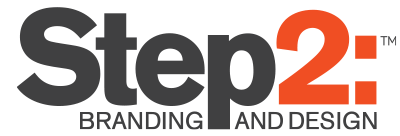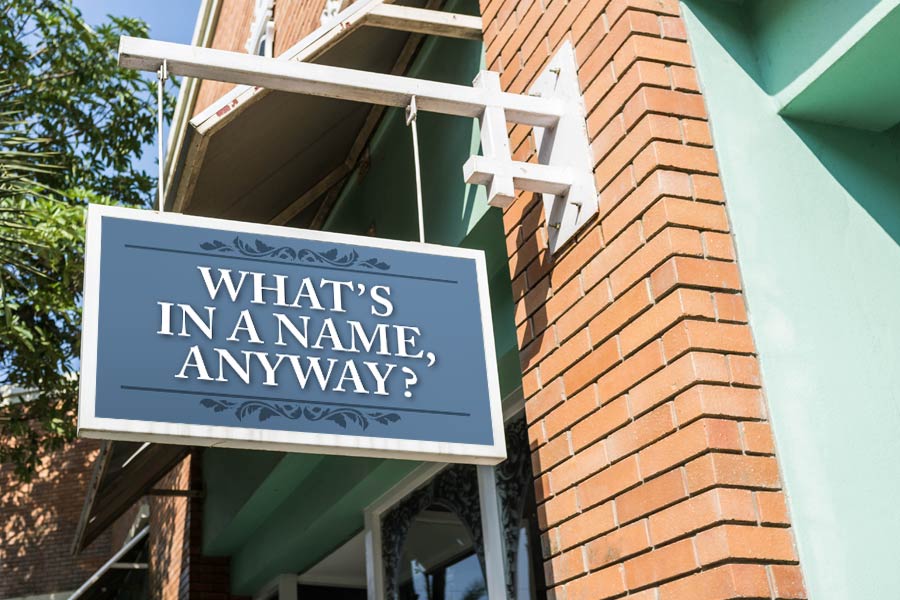Does the name of your business or organization mean anything to people other than you? Do you find yourself clarifying it or explaining why you chose it? The latter is not necessarily a bad thing, because it starts a conversation. However, it could indicate a missed opportunity to put a clear stake in the ground that means something to your prospects while reinforcing your Brand Promise.
People have often asked me, “Why Step 2?” It’s a fair question and, in our case, an opportunity to explain that, “Step 1 is the idea and Step 2 is how to present it.” Our primary message is that it’s never too early to begin thinking about branding, identity, and marketing. People immediately get it.
On the other hand, I know a business owner who is continually explaining to people what their business is not. Their name confuses their market into thinking they offer a different service. Sure, they can clarify it with a tagline, but you don’t always get that chance before losing your audience. In our case, if our business name didn’t include “Branding and Design,” we’d be facing the same challenge. In fact, we recently added the “and Design” part because we fell into the same trap of assuming people knew that we did more than just branding. You see, nobody is immune to this.
Then there’s the name that resembles a common word but is spelled differently. Usually, that name is chosen because the properly spelled one is already taken, the URL is unavailable, or someone simply wasn’t considering the ramifications. People are always misspelling it and forcing the company reps to clarify it, which can be very frustrating. It certainly doesn’t help when people are trying to find them online.
Another scenario is the name that’s a combination of other words or totally fictitious. At first, it means nothing, but offers a clean slate on which to build a messaging strategy. The organization can define it any way they choose. However, this approach typically requires significant time and awareness building efforts ($$) to really call it their own.
If your business is like ours, you don’t have a bottomless marketing budget to build awareness of a name that lacks clarity. We have to be more calculated and deliberate. So, having the right name out of the gate is vital to laying that first foundational block of your brand identity. This is no easy task. In fact, it’s the most challenging service we offer. (In a related post HERE, we outline three major hurdles of business naming.)
Think Long-term
Whatever approach you take, be sure to consider where your business will be years from now. Your name should stand the test of time and be high-level enough so that it provides flexibility to make strategic adjustments without it being compromised. Ideally, you’ll choose a name that is meaningful to your audience and reinforces your Brand Promise. Making sure it sends the right message to the right audience (remember, it’s about them, too, not just you) is vital, because it’s often their first impression. And, understanding that your wider audience extends beyond your immediate prospects (potential investors, industry influencers, local media, career-seekers) will help you build brand equity across a broader landscape.
So, what’s in a name, anyway? A Brand Promise. A marketing strategy with purpose. Originality. A meaningful takeaway. Clarity. Built-in longevity. Room to grow. And a lot of time and research. Our number 1 rule in naming is, “If it comes easily, it’s already taken.”
Brand vs. Brand Identity
Don’t confuse your brand identity with your brand. Your logo or name are not your brand. They are part of your brand identity. Your brand is your promise and what people think of when they hear your name. Consider Harley-Davidson and the lifestyle it promotes. Look at Nike’s “Just Do It.” and the way it challenges the audience. These examples both transcend the products to create a frame of mind that only they can own. If your brand is your promise to your market, brand equity (whether positive or negative) is based on your ability to deliver on it and the brand loyalty it generates. (See our infographic: Seven Stages of Achieving Brand Loyalty.)
Successful brand building makes customers willing to pay a premium for it. Think of Apple and the expectation of reliability, elegance, innovation, and a great user experience. That’s a tall promise to fulfill, but they do it well enough to overcome the inevitable bumps in the road. And there are always unforeseen setbacks and challenges.
Building brand equity requires regular upkeep through introspection, communicating regularly with your customers, evaluating your competitors, and gauging market trends.
Related Posts
I’m your potential customer and these are the things I care about.
You seem to be great at what you do. You have a terrific product. Your media coverage has been impressive. You’ve been serving the industry for decades. But, what does it mean to your customers? What’s in it for me?
15 ways your website could be hurting your business … and what you can do about it
Even if you’ve been able to put a check mark next to that spanking-new website on your marketing to-do list, get out your eraser. Your work has only just begun. A successful website is never once-and-done.
What’s your business DNA and where do you fit in?
It’s always a good idea to take a step back and be more introspective about your unique qualities and strengths. By looking beyond short-term distractions, we often discover that we still have a place to fit in.
Uncover your own path to greatness.
It’s important to look like you belong in your market. But, it’s more important to promote your own uniqueness. Remember, your brand and identity is about differentiation. It’s not about being like the others.
Many businesses make this one big marketing mistake. Is yours?
I recently visited the websites of some of the top design firms in the world. It was both inspiring and, truth be told, slightly intimidating. However, despite that, I did notice one consistent problem with a majority of them.
Are you trapped in a marketing bubble?
We often get too close to our business to see it the way others do. We build a virtual bubble around ourselves and lose the perspective needed to make sound strategic decisions.







